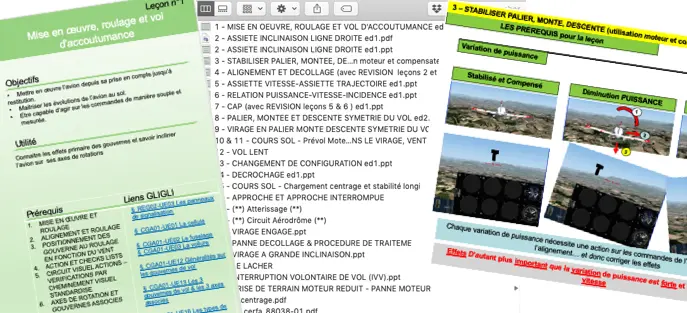Training
A microlight is a light aircraft governed by the same laws of mechanics as any other aircraft of the same type. A 3-axis microlight behaves like an airplane with a lower inertia but a higher weight/power ratio making this kind of machine "reactive" and sensitive "to the elements".
The structure of the flight lessons is that of the ENAC method I have chosen:
For its pedagogical rigour,
- Its well-timed in-flight information provided,
- Its flight-safe teaching framework
It is identical to what is taught in PPL, or LAPL. And for the most skeptical, this choice of method is motivated by the fact that today the FFPLUM (French Federation for Ultralights Aircrafts) largely uses this ENAC guide in its reference programs for microlight instructor training, a program "in fine" for student pilots.
- This method constitutes a solid basis for piloting that I will enrich with the particularities related to the practice of 3-axis microlights aircrafts.
- The training is carried out in two stages. The first consists of acquiring piloting techniques and leads to the "release" in solo flight. The second part deals more with navigation techniques, flight management, and practice.
If twenty hours of flight training seems a minimum, it is not always enough in the majority of cases to feel completely comfortable in this practice. This total number of hours of training also depends greatly on the learner's learning pace.
- Finally, let's not forget that a theory test on the ground must also be passed, which requires a good deal of personal work. It is once you have obtained the latter that you can be obtain your licence.
The radio qualification and its extension of privilege for IFR fields will be included in your beginner course
>> Radio qualification and IFR extension
The training process is to be considered engaging, it requires you to remain motivated, personal work and diligence.
The fruit of your efforts will then be crowned by the freedom to fly.
Méthode ENAC
The ENAC VFR Instructor's Guide used in certified aviation is also becoming a reference in the world of microlights.
This method has provved its worth and is now included in the instructor 's training program supported by the FFPLUM.
If, however, a method remains a method whose aspects can be further developed later, this one has the merit of having been matured by an institution of world renown in terms of training, so why deprive yourself of it...r...
The practice of this method means that the necessary and sufficient subjects to pilot responsibly are addressed through well-timed lessons with a progressive contribution of new knowledge .
In short, there is nothing to take away from it... even for microlights.


Teaching materials (documents in french)
You will be provided with a training support manual that will guide you:
- in learning the theoretical knowledge related to each of your flight lessons,
- in the learning of subjects related to your theory exam.


Personalized follow-up
The follow-up of your learning is the subject of a recording that we share with each flight.
The following flights are scheduled according to your level reached in the previous lessons.
The first 9 lessons will be the most important for your riding technique, we will pay special attention to them without trying to "skip the steps".
These lessons can be repeated if necessary, as the time saved on the acquisition of a skill unfortunately does not exist.
Around the lesson
The organization of the lessons is based on a point of preparation for the flight, a review at the end of it, or a long preparation when the need arises.
Of course, the personal work that may have been provided before each flight by the student, the learning of ground procedures will greatly facilitate their restitution in flight and therefore the speed of learning.

Briefing
Its purpose is to validate the theoretical knowledge necessary to understand the flight exercises. It is ideally positioned before each flight.
A detailed explanation of the exercises that will be carried out in flight is presented to you (the flight scenario) and will correspond to what I would have asked you to study in the pedagogical manual at the end of the previous lesson.

The lesson in flight
It will follow the flight scenario already presented which will take place in 3 well-respected steps for a better learning:
- I'll show you
- I accompany you
- You run alone
The in-flight sessions are about 40 minutes.

De-briefing
The end of a flight is an opportunity to take stock of the areas for improvement, but also and above all of what was successful and thus allow the student to know on which elements he must capitalize on for the rest of his training. I would like to specify the following lesson to be studied in the pedagogical manual that has been provided to you.

Long Briefing
An in-flight lesson is replaced by a theoretical and/or reminder of the procedures applicable in flight when it is highlighted that gaps in the student's knowledge are highlighted.
Similarly, at certain stages of flight training, ground school will be conducted in lieu of an in-flight lesson.
Radio Qualification and IFR extension
The radio qualification is included in the initial training as well as its extension of privilege (decree of 12 July 2019 part F):
For pilots who are already licensed but do not yet have these rights, I also offer a complementary training service (radio and/or privilege extension).




